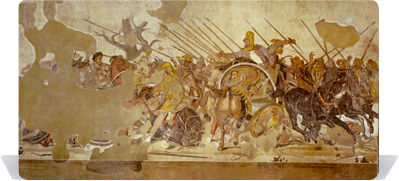The Alexander Mosaic
The Alexander Mosaic was found during the excavation of Pompeii in 1831 in the “Casa del Fauno” (House of the Faun). Today it is one of the most famous Roman mosaics. Measuring 5.82 x 3.13 m, the mosaic is thought by many to depict the Battle of Issus between Alexander the Great and the Persian king Darius III in the year 333 BC. Others however believe that the tableau shows the battle of Gaugamela in the year 331 BC, where Alexander the Great and Darius clashed once again.
The picture shows Alexander storming in at the head of his troops from the left edge, attempting to engage Darius in battle. But the Persian has already turned to flee, with only his eyes directed towards Alexander.

The Alexander Mosaic, independently of its fitting in the “Casa del Fauno”, was created in the 3rd century BC and based on an original no longer in existence. The original may have been the work of Philoxenos of Eretrea from the 4th century BC. There is also a belief that a Hellenistic painting was used as the model. The mosaic shows the magnificence of Greek monumental painting and four-colour painting.
Today, the original Alexander Mosaic is on display in the National Museum of Archaeology in Naples. An exact copy – identical in shape, size, colour and materials used – was created after several years of work by the Scuola Bottega del Mosaico di Ravenna and is now installed in Pompeii.
